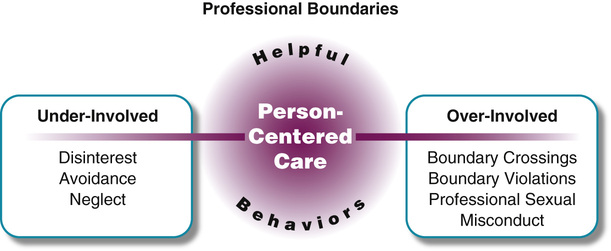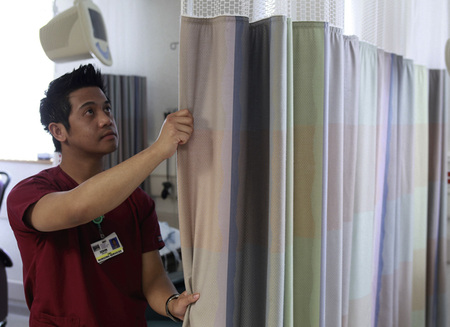Ethics and Laws
Objectives
• Define the key terms and key abbreviations in this chapter.
• Describe the rules of conduct for nursing assistants.
• Explain how to maintain professional boundaries.
• Explain how to prevent negligent acts.
• Give examples of false imprisonment, defamation, assault, battery, and fraud.
• Describe how to protect the right to privacy.
• Explain the correct use of electronic communications.
• Explain the purpose of informed consent.
• Describe elder, child, and domestic abuse.
• Explain your role in relation to wills.
• Explain how to promote PRIDE in the person, the family, and yourself.
Key Terms
Key Abbreviations
| CDC | Centers for Disease Control and Prevention |
| HIPAA | Health Insurance Portability and Accountability Act of 1996 |
| IPV | Intimate partner violence |
| OBRA | Omnibus Budget Reconciliation Act of 1987 |
Nurse practice acts, your training and job description, and safe delegation serve to protect patients and residents from harm (Chapters 3 and 4). Protecting them from harm also involves a complex set of rules and standards of conduct. They form the ethical and legal aspects of care.
Ethical Aspects
Ethics is knowledge of what is right conduct and wrong conduct. Morals are involved. Morals involve right and wrong and good and bad behavior. Ethics also deals with choices or judgments about what should or should not be done. An ethical person behaves and acts in the right way. He or she does not cause a person harm.
Ethical behavior also involves not being prejudiced or biased. To be prejudiced or biased means making judgments and having views before knowing the facts. Your judgments and views usually are based on your values and standards. They are based on your culture, religion, education, and experiences. The person’s situation and yours may be very different. For example:
Do not judge the person by your values and standards. Do not avoid persons whose standards and values differ from your own.
Ethical problems involve making choices. What is the right thing to do? For example:
Codes of Ethics
Professional groups have codes of ethics. A code of ethics has rules, or standards of conduct, for group members to follow. The American Nurses Association (ANA) has a code of ethics for registered nurses (RNs). The National Federation of Licensed Practical Nurses has 1 for licensed practical nurses/licensed vocational nurses (LPNs/LVNs). The rules of conduct in Box 5-1 can guide your thinking and behavior. See Chapter 6 for student and work ethics.
Professional Boundaries
A boundary limits or separates something. For example, a fence forms a boundary. You stay inside or outside of the fenced area. As a nursing assistant, you enter into a helping relationship with patients, residents, and families. The helping relationship has professional boundaries.
Professional boundaries separate helpful behaviors from behaviors that are not helpful (Fig. 5-1). The boundaries create a helpful zone. Your behavior must help the person. If you are under-involved, the following can occur.
If you are over-involved, the following can occur.
• Boundary crossing is a brief act or behavior of being over-involved with the person. The intent of the act or behavior is to meet the person’s needs. The act or behavior may be thoughtless or something you did not mean to do. Or it could have purpose if it meets the person’s needs. For example, you give a crying patient a hug. The hug meets the person’s needs at the time. If the hug meets your needs, the act is wrong. Also, it is wrong to hug the person every time you see him or her.
• Boundary violation is an act or behavior that meets your needs, not the person’s. The act or behavior is not ethical. It violates the code of conduct in Box 5-1. The person can be harmed. Boundary violations include:
• Keeping secrets with the person.
• Professional sexual misconduct is an act, behavior, or comment that is sexual in nature. It is sexual misconduct even if the person consents or makes the first move.
Some boundary violations and some types of professional sexual misconduct also are crimes. To maintain professional boundaries, follow the rules in Box 5-2. Be alert to boundary signs. Boundary signs are acts, behaviors, or thoughts that warn of a boundary crossing or boundary violation (Box 5-3).
See Focus on Communication: Professional Boundaries.
Legal Aspects
Ethics is about what you should or should not do. Laws tell you what you can and cannot do. A law is a rule of conduct made by a government body. The U.S. Congress and state legislatures make laws. Enforced by the government, laws protect the public welfare.
Criminal laws are concerned with offenses against the public and society in general. An act that violates a criminal law is called a crime. A person found guilty of a crime is fined or sent to prison. Murder, robbery, stealing, rape, kidnapping, and abuse (p. 44) are crimes.
Civil laws are concerned with relationships between people. Examples of civil laws are those that involve contracts and nursing practice. A person found guilty of breaking a civil law usually has to pay a sum of money to the injured person.
Torts
Tort comes from the French word meaning wrong. Torts are part of civil law. A tort is a wrong committed against a person or the person’s property. Some torts are unintentional. Harm was not intended. Some torts are intentional. The act was done on purpose and harm was intended.
Negligence and Malpractice.
Negligence is an unintentional wrong. The negligent person did not act in a reasonable and careful manner. As a result, a person or the person’s property was harmed. The person causing the harm did not intend or mean to cause harm. The person failed to do what a reasonable and careful person would have done. Or he or she did what a reasonable and careful person would not have done. The negligent person may have to pay damages (a sum of money) to the one injured.
Malpractice is negligence by a professional person. A person has professional status because of his or her education and the service provided. Nurses, doctors, dentists, and pharmacists are examples.
What you do or do not do can lead to a lawsuit if you harm a person or the property of another. Standard of care refers to the skills, care, and judgments required by a health team member under similar conditions. Standards of care come from:
• Laws, including nurse practice acts and those relating to nursing assistants.
• Agency policy books and procedure manuals (Fig. 5-2, p. 42). Policy books are guides for staff conduct. Procedure manuals explain how to perform certain procedures.
• Manufacturer’s instructions for equipment and supplies.
• Approval and accrediting agency standards.
The following actions could lead to charges of negligence.
You are legally responsible (liable) for your own actions. The nurse is liable as your supervisor. However, you have personal liability. Remember, sometimes refusing to follow the nurse’s directions is your right and duty (Chapter 4).
Defamation.
Defamation is injuring a person’s name and reputation by making false statements to a third person.
• Libel is making false statements in print, in writing (including e-mail and text messages), through pictures or drawings, through broadcast (radio, TV, or video), posted on-line on websites, or through video sites and social media sites. See “Wrongful Use of Electronic Communications.”
• Slander is making false statements through the spoken word, sounds, sign language, or gestures.
Examples of defamation include:
• Implying or suggesting that a person uses drugs
• Saying that a person is insane or mentally ill
• Posting on-line that a co-worker was fired for hitting a resident
• Implying or suggesting that a person steals money from the staff
To protect yourself from defamation, never make false statements about a patient, resident, family member, visitor, co-worker, or any other person. This includes:
False Imprisonment.
False imprisonment is the unlawful restraint or restriction of a person’s freedom of movement. It involves:
Invasion of Privacy.
Invasion of privacy is violating a person’s right not to have his or her name, photo, or private affairs exposed or made public without giving consent. You must treat the person with respect and ensure privacy. Only staff involved in the person’s care should see, handle, or examine his or her body. See Box 5-4 for measures to protect privacy.
Health Insurance Portability and Accountability Act of 1996.
The Health Insurance Portability and Accountability Act of 1996 (HIPAA) protects the privacy and security of a person’s health information. Protected health information refers to identifying information and information about the person’s health care that is maintained or sent in any form (paper, electronic, oral). Failure to follow HIPAA rules can result in fines, penalties, and criminal actions including jail time.
To avoid HIPAA violations:
• Always follow agency policies and procedures.
• Only discuss the person’s health information with staff directly involved in the person’s care.
You may be asked questions about the person or the person’s care. Direct any questions about the person or the person’s care to the nurse. Also follow the rules for using computers and other electronic devices (Chapter 7).
Fraud.
Fraud is saying or doing something to trick, fool, or deceive a person. The act is fraud if it does or could harm a person or the person’s property. Telling a person or family that you are a nurse is fraud. So is giving wrong or incomplete information on a job application.
Assault and Battery.
Assault and battery may result in both civil and criminal charges.
• Assault is intentionally attempting or threatening to touch a person’s body without the person’s consent. The person fears bodily harm. Threatening to “tie down” a person is an example of assault.
• Battery is touching a person’s body without his or her consent. The person must consent to any procedure, treatment, or other act that involves touching the body. The person has the right to withdraw consent at any time.
Protect yourself from being accused of assault and battery. Explain to the person what you are going to do and get the person’s consent. Consent may be verbal—“yes” or “okay.” Or it can be a gesture—a nod, turning over for a back rub, or holding out an arm for you to take a pulse.
Wrongful Use of Electronic Communications
Electronic communications include e-mail, text messages, faxes, websites, video sites, and social media sites. Video and social media sites include Facebook, Twitter, LinkedIn, YouTube, Instagram, blogs and comments to blog postings, chat rooms, bulletin boards, and so on. Other forms of electronic communications are expected in the future.
Correct use of electronic communications is essential in your personal life and as a member of the health and nursing teams. Follow the rules in Box 5-5. Do so whether using a computer, wireless phone, camera, or other electronic device at home, at school, at work, or in any other setting. Wrongful use of electronic communications can result in job loss and loss of your certification (license, registration) for:






